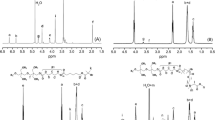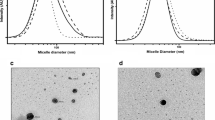Abstract
Macrolide antibiotics are lipophilic drugs with some limitations including low solubility, limited cellular permeation, patients discomfort, etc. With amphiphilic methoxy poly(ethylene glycol)-b-poly(ε-caprolactone) (MPEG-PCL) copolymer and azithromycin (AZT) as drug carrier and model drug, AZT-loaded micelles were prepared via thin-membrane hydration method in order to overcome these limitations. Encapsulation efficiency of AZT-loaded micelles was 94.40% with good storage stability for 28 days, and AZT’s water solubility was enhanced to 944 μg/mL. Fourier transform infrared spectrum and x-ray diffraction analysis indicated that AZT was enveloped into the micelles in amorphous form due to its interaction with the copolymer. AZT’s in vitro release from the AZT-loaded micelles demonstrated a slow and continuous behavior when compared with raw AZT. The release dynamics was accorded with Weibull equation, meaning that release amount of AZT lowered with time and was proportional to remaining amount of drug in the AZT-loaded micelles. Korsmeyer-Peppas fitting result suggested that drug release process was a classical Fickian diffusion-controlled manner. With Staphylococcus aureus as bacterial strain, antibacterial activity of the AZT-loaded micelles displayed was comparable with raw AZT. In conclusion, MPEG-PCL should be a promising carrier for macrolide antibiotic delivery in treatment of bacterial infections.





Similar content being viewed by others
References
Bradbury F. Comparison of azithromycin versus clarithromycin in the treatment of patients with lower respiratory tract infection. J Antimicrob Chemother. 1993;31(suppl_E):153–62.
Fernandez-Obregon AC. Azithromycin for the treatment of acne. Int J Dermatol. 2000;39(1):45–50.
Kalhapure RS, Suleman N, Mocktar C, Seedat N, Govender T. Nanoengineered drug delivery systems for enhancing antibiotic therapy. J Pharm Sci. 2015;104(3):872–905.
Azhdarzadeh M, Lotfipour F, Zakeri-Milani P, Mohammadi G, Valizadeh H. Anti-bacterial performance of azithromycin nanoparticles as colloidal drug delivery system against different gram-negative and gram-positive bacteria. Adv Pharm Bull. 2012;2(1):17–24.
Mohammadi G, Valizadeh H, Barzegar-Jalali M, Lotfipour F, Adibkia K, Milani M, et al. Development of azithromycin-PLGA nanoparticles: physicochemical characterization and antibacterial effect against Salmonella typhi. Colloids Surf B Biointerfaces. 2010;80(1):34–9.
Toti US, Guru BR, Hali M, McPharlin CM, Wykes SM, Panyam J, et al. Targeted delivery of antibiotics to intracellular chlamydial infections using PLGA nanoparticles. Biomaterials. 2011;32(27):6606–13.
Kwon GS, Kataoka K. Block copolymer micelles as long-circulating drug vehicles. Adv Drug Del Rev. 2012;64(2–3):237–45.
Liu L, Venkatraman SS, Yang YY, Guo K, Lu J, He B, et al. Polymeric micelles anchored with TAT for delivery of antibiotics across the blood-brain barrier. Biopolymers. 2010;90(5):617–23.
Sinha VR, Bansal K, Kaushik R, Kumria R, Trehan A. Poly-epsilon-caprolactone microspheres and nanospheres: an overview. Int J Pharm. 2004;278(1):1–23.
Song ZM, Zhu WX, Liu N, Yang FY, Feng RL. Linolenic acid-modified PEG-PCL micelles for curcumin delivery. Int J Pharm. 2014;471(1–2):312–21.
Gou M, Men K, Shi H, Xiang M, Zhang J, Song J, et al. Curcumin-loaded biodegradable polymeric micelles for colon cancer therapy in vitro and in vivo. Nano. 2011;3(4):1558–67.
Gong C, Deng S, Wu Q, Xiang M, Wei X, Li L, et al. Improving antiangiogenesis and anti-tumor activity of curcumin by biodegradable polymeric micelles. Biomaterials. 2013;34(4):1413–32.
Wang BL, Shen YM, Zhang QW, Li YL, Luo M, Liu Z, et al. Codelivery of curcumin and doxorubicin by MPEG-PCL results in improved efficacy of systemically administered chemotherapy in mice with lung cancer. Int J Nanomedicine. 2013;8:3521–31.
Kheiri Manjili H, Ghasemi P, Malvandi H, Mousavi MS, Attari E, Danafar H. Pharmacokinetics and in vivo delivery of curcumin by copolymeric mPEG-PCL micelles. Eur J Pharm Biopharm. 2017;116:17–30.
Sun CT, Zhou L, Gou ML, Shi S, Li T, Lang JY. Improved antitumor activity and reduced myocardial toxicity of doxorubicin encapsulated in MPEG-PCL nanoparticles. Oncol Rep. 2016;35(6):3600–6.
Soliman GM, Attia MA, Mohamed RA. Poly(ethylene glycol)-block-poly(epsilon-caprolactone) nanomicelles for the solubilization and enhancement of antifungal activity of sertaconazole. Curr Drug Del. 2014;11(6):753–62.
Song Z, Zhu W, Song J, Wei P, Yang F, Liu N, et al. Linear-dendrimer type methoxy-poly (ethylene glycol)-b-poly (epsilon-caprolactone) copolymer micelles for the delivery of curcumin. Drug Deliv. 2015;22(1):58–68.
Lee H, Zeng F, Dunne M, Allen C. Methoxy poly(ethylene glycol)-block-poly(δ-valerolactone) copolymer micelles for formulation of hydrophobic drugs. Biomacromolecules. 2005;6(6):3119–28.
Gong C, Xie Y, Wu Q, Wang Y, Deng S, Xiong D, et al. Improving anti-tumor activity with polymeric micelles entrapping paclitaxel in pulmonary carcinoma. Nano. 2012;4(19):6004–17.
Aucamp M, Odendaal R, Liebenberg W, Hamman J. Amorphous azithromycin with improved aqueous solubility and intestinal membrane permeability. Drug Dev Ind Pharm. 2015;41(7):1100–8.
Yadav AK, Mishra P, Jain S, Mishra P, Mishra AK, Agrawal GP. Preparation and characterization of HA–PEG–PCL intelligent core–corona nanoparticles for delivery of doxorubicin. J Drug Target. 2008;16(6):464–78.
Zuo J, Gao Y, Bouchacra N, Löbenberg R. Evaluation of the DDSolver Software Applications. Biomed Res Int. 2014;2014(4):204925.
Zhang Y, Huo M, Zhou J, Zou A, Li W, Yao C, et al. DDSolver: an add-in program for modeling and comparison of drug dissolution profiles. AAPS J. 2010;12(3):263–71.
Sharma R, Walker RB, Pathak K. Evaluation of the kinetics and mechanism of drug release from econazole nitrate nanosponge loaded carbapol hydrogel. Indian J Pharm Edu Res. 2011;45(1):25–31.
Gandhi A, Jana S, Sen KK. In-vitro release of acyclovir loaded Eudragit RLPO® nanoparticles for sustained drug delivery. Int J Biol Macromol. 2014;67(Supplement C):478–82.
Funding
This work is supported by the Natural Science Foundation of Shandong Province under grant number ZR2016BL15, and Science and Technology Project of University of Jinan under grant number XKY1732.
Author information
Authors and Affiliations
Corresponding author
Ethics declarations
Conflict of Interest
The authors declare that they have no conflicts of interest.
Rights and permissions
About this article
Cite this article
Wei, W., Li, S., Xu, H. et al. MPEG-PCL Copolymeric Micelles for Encapsulation of Azithromycin. AAPS PharmSciTech 19, 2041–2047 (2018). https://doi.org/10.1208/s12249-018-1009-0
Received:
Accepted:
Published:
Issue Date:
DOI: https://doi.org/10.1208/s12249-018-1009-0




